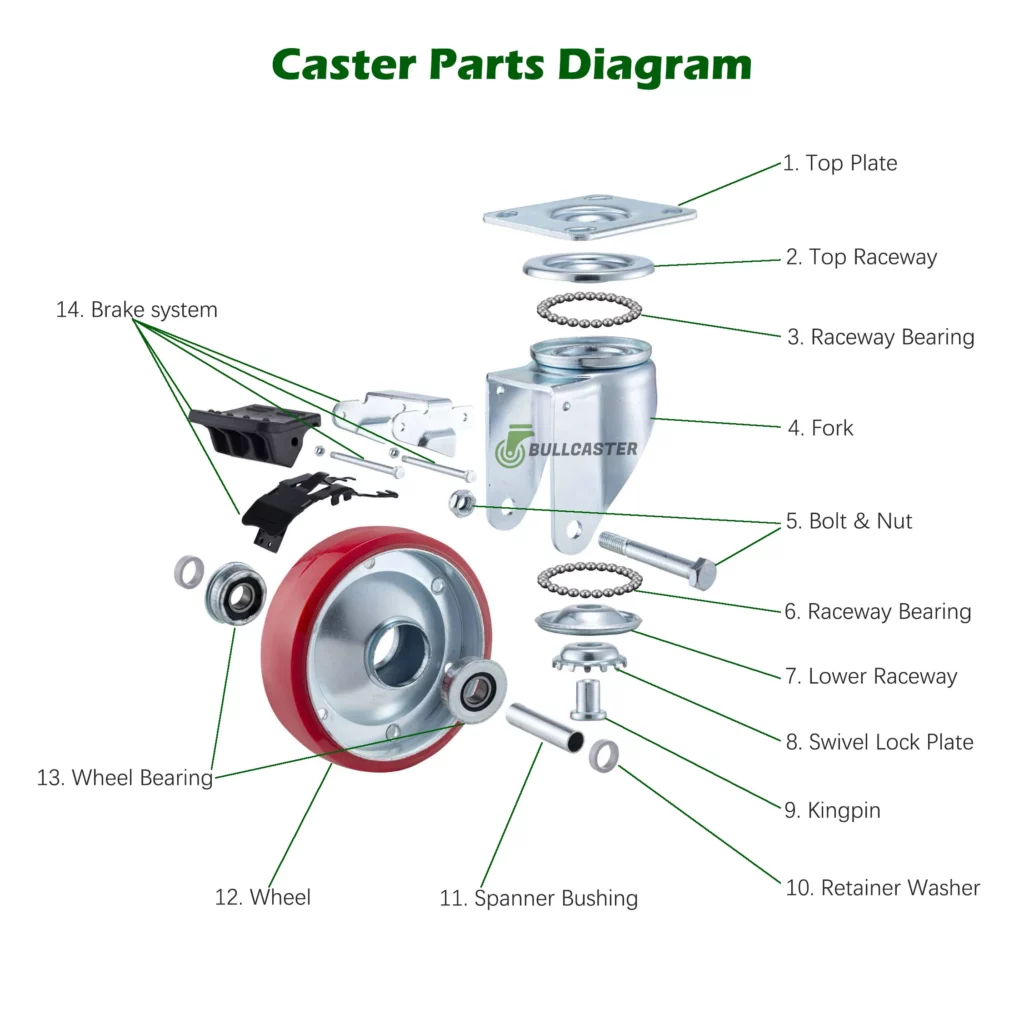キャスターは何の部品でできているかご存知ですか?
キャスターの各部の役割をご存知ですか?
この記事ではキャスターホイールの組み立てについて詳しく紹介します。
下の写真を見てください。うちは日本語を使ってます 頑丈な工業用キャスター 説明として。現在市販されている工業用キャスターは構造的には同じであり、一般的な工業用キャスター組立品と言えます。

キャスターホイール部品紹介
A. キャスター天板(1)
天板はキャスターの取付板であり、キャスターブラケットの一部です。キャスターの取り付けを容易にするために、天板には通常4~6個の下穴が開けられています。
キャスターにはキャスター天板の他にステム、ボルトホール、エキスパンドステム、リジッドなど様々な取り付け方法があります。詳しくは前回の記事をご覧ください。 キャスター取り付けタイプ。
天板の厚さはキャスターの耐荷重を決める要素の一つであることに注意してください。通常はユーザーのニーズに合わせてキャスター金具や天板の厚みを厚くし、大幅な増量を実現します。 キャスターの耐荷重。
B. キャスター軌道と軌道軸受(2.3.6.7)
キャスターホイール軌道は、スイベルキャスターのコンポーネントです。キャスター ホイールの軌道は、本質的にキャスターの静止部分と回転部分の間のインターフェイスです。これは 2 つの主要な部分で構成されます。
- 内輪軌道:ステムやキャスターの取付板に取り付けて固定する部品です。
- 外輪軌道: この部品はホイールアセンブリに取り付けられており、回転または旋回する部品です。
これら 2 つの軌道の間には、通常、ボール ベアリングまたはローラー ベアリングなどのベアリングが設置されています。これらのベアリングは、キャスターの静止部分に対するホイール アセンブリのスムーズな回転または旋回を促進します。軌道によりキャスターは 360 度回転し、最小限の力でスムーズに方向を変えることができます。
仕組みは次のとおりです。
- スイベルヘッド: キャスターの上部の軌道が位置する部分です。スイベルヘッドにより、キャスターは垂直軸を中心に回転できます。
- トップレースウェイ: 軌道自体は、ボール ベアリングが配置される一連の円形トラックです。これらのベアリングにより、スイベルヘッドは最小限の摩擦でスムーズに回転します。上部軌道面は、強度を高め、回転をよりスムーズにするために、ダブルボール軌道面であることがよくあります。
- ボールベアリング: これらの小さな金属ボールは軌道内に配置されており、キャスターの可動部分間の摩擦を軽減し、スムーズな動きを促進します。
軌道の設計と構造は、キャスターの性能と耐久性にとって非常に重要です。適切に設計された軌道により摩擦が軽減され、動きが容易になり、耐荷重能力が向上します。これは、キャスターがかなりの重量を支えて移動する必要がある産業用途やヘビーデューティ用途では特に重要です。
C. キャスターホイールブラケットフォーク (4)
キャスターホイールブラケットフォークは、ホイールボルト、天板、キャスターブレーキシステムを接続する構造です。
材質は通常鋼板で、表面処理は亜鉛メッキ、電気泳動塗装、クロムメッキなどが一般的です。 ステンレス鋼 バー。
ブラケットフォークの材質と厚さもキャスターの耐荷重に影響を与える重要な要素であることに注意してください。
D. ボルトとナット (5)
ボルトとナットの主な機能は、ホイールをキャスター ブラケットに取り付けて、ホイールとブラケットが使用可能なキャスターを形成することです。頑丈なキャスターには、より太く高強度のボルトを使用する必要があります。
E. スイベルロックプレート (8)
キャスター ホイール回転ロック プレートは、キャスターの回転動作をロックする機能を提供するために、特定のタイプのキャスターで使用されるコンポーネントです。この機能は、一時的または永続的に回転キャスターを固定キャスターに変換する必要がある用途に特に役立ちます。
スイベルロックプレートを使用すると、キャスターのスイベル機構をロックできます。ロックがかかると、キャスターが垂直軸を中心に回転するのが防止され、回転キャスターが剛性のある非回転キャスターに変わります。これは、安定性が必要な場合や、キャスターがずれることなく真っ直ぐに移動する必要がある場合に役立ちます。
F.キングピン (9)
キングピンの機能は、キャスターのトップ プレート、レースウェイ、フォーク、スイベル ロック、その他のコンポーネントを組み合わせて完全なキャスター ブラケットを形成することです。
G. キャスターホイールベアリング (10.11.13)
キャスターホイールのベアリングは摩擦を軽減し、スムーズで簡単なホイールの回転を可能にするために非常に重要です。特に重い荷重下での可動性が向上し、キャスターの全体的な耐荷重能力に貢献します。キャスターベアリングには多くの種類があります。についての私の以前の記事をチェックしてください。 キャスターベアリングの導入。
H. キャスターの車輪(10.11.13)
ホイールは、ベアリング、スパナブッシュ、リテーナーワッシャー、ボルト、ナットを介してキャスターブラケットに取り付けられます。
ホイールにはさまざまな種類、さまざまな素材、さまざまなサイズがあります。多くの場合、さまざまなニーズに応じてさまざまなタイプのホイールを選択する必要があります。あなたは私たちをチェックすることができます キャスター材質のご案内 あなたのニーズに最適なホイールをお選びください。
I. キャスターホイールブレーキAssy(10.11.13)
キャスターホイールブレーキは、キャスターを所定の位置にロックして車輪の回転を防ぐためにキャスターに追加された機構です。この機能は、特にキャスターが重い荷物を支えたり傾斜したりする用途において、安定性と安全性を確保するために不可欠です。ブレーキは手動で (多くの場合はフット ペダルを使用して) かけることができ、作動するとホイールまたはそのハウジングに圧力を加えて動きを停止します。キャスター ブレーキには、旋回動作もロックしてキャスターを完全に動かないようにするトータル ロック ブレーキなど、さまざまなタイプがあります。
キャスターをご購入の場合は、 お問い合わせ ブルキャスター 直接、包括的なキャスター ソリューションを提供できます。


